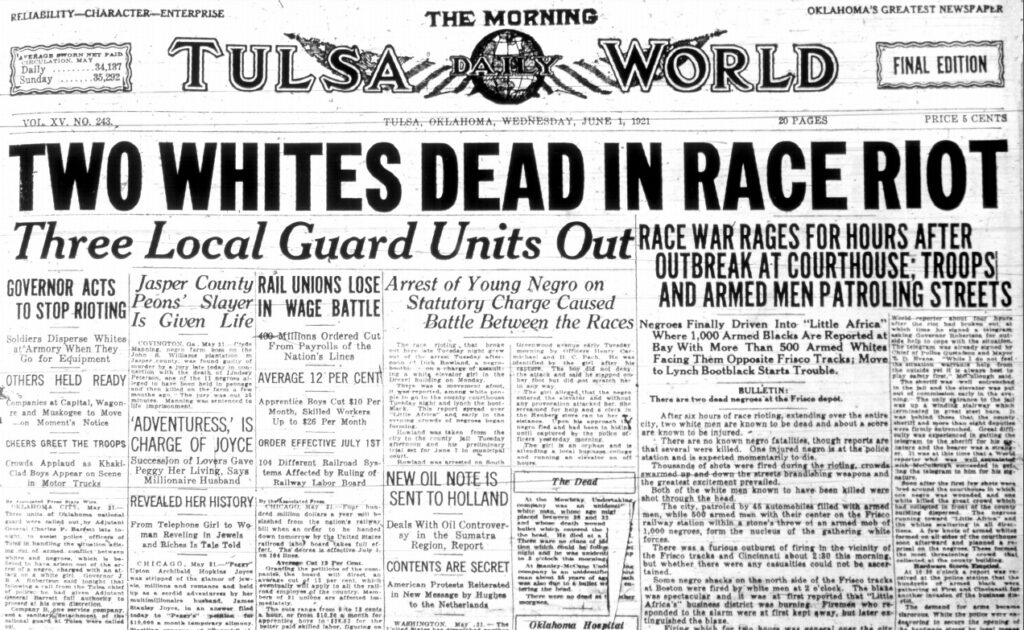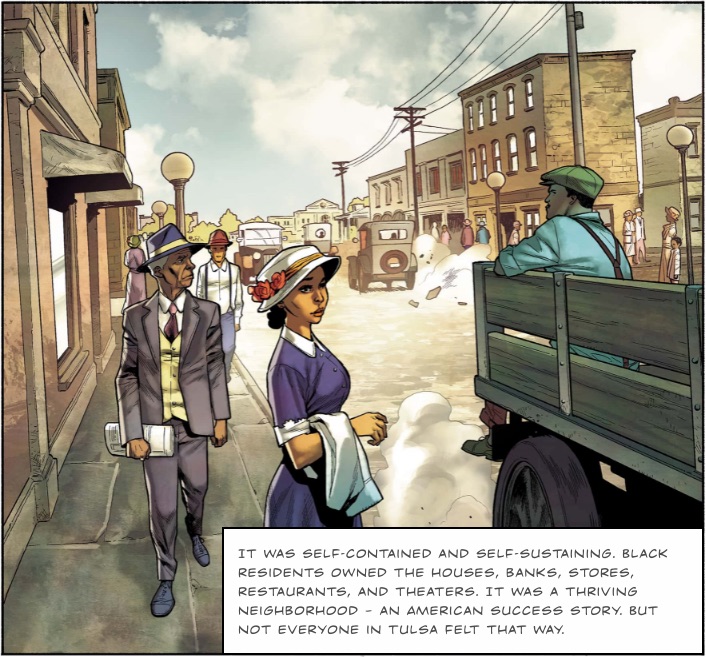Photo from the 1921 Tulsa Massacre. Public domain, photographer unknown.
Tap to view at full size.In the early 1900s, Greenwood, an area of Tulsa, Oklahoma, had a thriving Black business community. By 1921, it covered an area of 35 blocks and was home to 11,000 Black people and their 200 businesses, which included 31 restaurants, almost as many grocers, 5 hotels, 4 drugstores, and 2 theaters. There were also a dozen churches, 2 schools, 2 hospitals, 2 newspapers, and a public library. It had a professional class comprising 15 doctors, one of whom was nationally acclaimed surgeon, 3 lawyers (including Buck Colbert Franklin, who contributed to the landmark case of Brown v. Board of Education and marched at Selma), and several business people.
Greenwood was a Black Wall Street at a time when most Black people in the southern U.S. were sharecroppers working on plantations with White owners. It was the wealthiest Black community in the U.S. at the time. On this day 100 years ago — May 31, 1921 — that changed. That’s when white rioters, fueled by racism and resentment, burned it down.
The comic panels below, taken from The Massacre of Black Wall Street, a promotion for the Watchmen TV series in The Atlantic, illustrate the story.
The massacre happened on the Memorial Day weekend of 1921 when 19-year-old Dick Rowland, a young Black man who shined shoes, was accused of assaulting 17-year-old Sarah Page, a young White girl who operated the elevator of Tulsa’s Drexel Building.
The most accepted accounts of the incident say that Rowland tripped while entering the elevator, and tried to break his fall, grabbing Page’s arm in the process. Page screamed, and a White clerk called police, reporting what happened as an assault.
Rowland was arrested the next day, and in a fit of race panic, local newspaper the Tulsa Tribune reported that Rowland had attacked Page and torn her clothes.
Page refused to press charges, but it didn’t matter.
Lest you think that the headline from the comic panel above is artistic license, here’s a scan of the actual article, and yes, the headline did actually read Nab Negro for AttackingGirl [sic] In an Elevator:

The following is an excerpt from Wikipedia’s entry on the massacre, from the section titled Stand-off at the courthouse:
The afternoon edition of the Tribune hit the streets shortly after 3 p.m., and soon news spread of a potential lynching. By 4 p.m., local authorities were on alert. White residents began congregating at and near the Tulsa County Courthouse. By sunset around 7:30 p.m., the several hundred White residents assembled outside the courthouse appeared to have the makings of a lynch mob. Willard M. McCullough, the newly elected sheriff of Tulsa County, was determined to avoid events such as the 1920 lynching of White murder suspect Roy Belton in Tulsa, which had occurred during the term of his predecessor.[58] The sheriff took steps to ensure the safety of Rowland. McCullough organized his deputies into a defensive formation around Rowland, who was terrified.[failed verification] The Guthrie Daily Leader reported that Rowland had been taken to the county jail before crowds started to gather.[59] The sheriff positioned six of his men, armed with rifles and shotguns, on the roof of the courthouse. He disabled the building’s elevator and had his remaining men barricade themselves at the top of the stairs with orders to shoot any intruders on sight. The sheriff went outside and tried to talk the crowd into going home but to no avail. According to an account by Scott Ellsworth, the sheriff was “hooted down”.[60] At about 8:20 p.m., three White men entered the courthouse, demanding that Rowland be turned over to them. Although vastly outnumbered by the growing crowd out on the street, Sheriff McCullough turned the men away.[61]
Crowds of Black and White people converged on the courthouse. Then this happened:
The gunshots triggered an almost immediate response, with both sides firing on the other. The first “battle” was said to last a few seconds or so, but took a toll, as ten Whites and two Black men lay dead or dying in the street.[58] The Black men who had offered to provide security retreated toward Greenwood. A rolling gunfight ensued. The armed White mob pursued the Black contingent toward Greenwood, with many stopping to loot local stores for additional weapons and ammunition. Along the way, bystanders, many of whom were leaving a movie theater after a show, were caught offguard by the mobs and fled. Panic set in as the White mob began firing on any Black people in the crowd. The White mob also shot and killed at least one White man in the confusion.[66] According to the Oklahoma Historical Society some in the mob were deputized by police and instructed to “get a gun and get a nigger”.[67]
This erupted into a full-blown race riot, with:
- Small groups of White attackers firing guns indiscriminately into Greenwood homes and businesses.
- Rioters accosting White families who employed Black people, demanding that they be turned over to be taken into detention.
- The random appointment of 250 to 500 White men (and some youths) as “special deputies” with the authority to shoot and kill Black people whom they viewed as in rebellion against white Tulsans.
- A White mob setting fires in Greenwood’s commercial district, and when the fire department arrived to put out the fires, they were turned away at gunpoint:
“It would mean a fireman’s life to turn a stream of water on one of those negro buildings. They shot at us all morning when we were trying to do something but none of my men were hit. There is not a chance in the world to get through that mob into the negro district.”[59]
- Attack by air: private aircraft were dispatched from a nearby airfield, from which shots were fired, and it is reported that small handheld bombs or accelerants were dropped from them as well.

In the end:
- 100 to 300 Greenwood residents were killed.
- 9,000 Greenwood residents were burned out of their homes.
- 1,200 Greenwood buildings were destroyed.
- All told, the massacre resulted in $50 to $100 million in property damage.
Here’s how the Tulsa Daily World covered the massacre. The headline makes it clear who really mattered to them:
 Here’s an excerpt from Photographing the Tulsa Massacre of 1921, an article in The Public Domain Review:
Here’s an excerpt from Photographing the Tulsa Massacre of 1921, an article in The Public Domain Review:
The white Tulsans who invaded Greenwood similarly portrayed themselves as protectors, defending their community against an armed “negro uprising”. Through taking or sharing photos of destroyed Greenwood buildings and, especially, of armed whites escorting Black men with their hands raised in surrender, white participants and onlookers sought to demonstrate that white Tulsans had succeeded in thwarting Black violence. Captions such as “Running the Negro out of Tulsa”, “Little Africa on Fire”, and “Herding Them in the Convention Hall” are indicative of this cultural ethos.28 Race massacre photos were valued as souvenirs that enabled their authors to credibly inscribe themselves into a triumphalist narrative.29 This is particularly true of those later sold as photo postcards, which also allowed those who purchased and sent them, as well as the recipients who then viewed them, to vicariously share in that triumph.
Buried history
Great pains have been taken to bury this part of history. If you look at Wikipedia’s list of references to the 1921 Tulsa Massacre in popular culture, most of them are from this millennium, and none of them come before 1998. I myself only know about it from reading Ta-Nehisi Coates’ 2014 article in The Atlantic, The Case for Reparations.
According to Dr. Scott Ellsworth, professor of Afroamerican and African Studies at the University of Michigan:
“For 50 years, the story was actively suppressed in Tulsa, and it was deliberately kept out of the White newspapers. The people who brought it up were threatened with their jobs; they were threatened with their lives.”
Awareness of the massacre grew thanks to this 2019 piece from Vox…
…as well as dramatizations in two TV series from 2020: Watchmen…
…and Lovecraft Country:
Here’s where you can find out more about what happened 100 years ago today:
- The Atlantic — The Massacre of Black Wall Street
- Wikipedia — Tulsa Race Massacre
- Tulsa Historical Society & Museum — 1921 Tulsa Race Massacre
- New York Times — What the 1921 Tulsa Race Massacre Destroyed
- The Public Domain Review — Photographing the Tulsa Massacre of 1921
- NPR — 3 Documentaries You Should Watch About The Tulsa Race Massacre
- And, if you need to have your opinion of Fox News followers lowered even more, go to their piece Tulsa massacre documentaries offer deep dive into tragedy and scroll down to the comments.
![Photo depicting a burning cityscape during the Tulsa Race Massacre on June 1, 1921. Handwritten caption reads “Runing [sic] the negro out of Tulsa June th 1 [sic] 1921.””](https://www.joeydevilla.com/wp-content/uploads/2021/05/1921_Tulsa_Massacre_postcard-1024x735.jpg)






